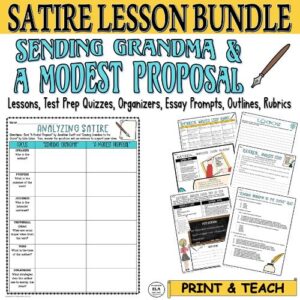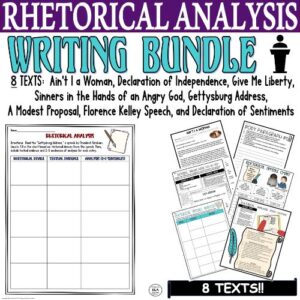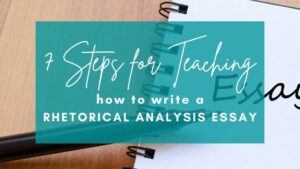Whether you’re teaching rhetorical analysis for the first time or the fiftieth, you’re probably looking for strategies that aren’t overcomplicated. Well this post, with its 10 rhetorical strategies that any student can learn, is for you!
Rhetorical analysis involves looking beyond just what is said in a text in order to focus on how things are said. A reader using rhetorical strategies for their analysis should ask what the author’s goals are and then examine how the author accomplishes those goals in writing.
Exploring the ‘how’ of writing is important since it promotes critical thinking. Examining and understanding tone, imagery, structure, and more, along with logos, ethos, and pathos in a text creates students who learn to dig more deeply. They are then better able to examine rhetoric in other texts in today’s society.
There is, therefore, a clear link between the rhetorical analysis you do in your classroom and developing informed citizens that students can (and will be) beyond your classroom!
Need help with Test Prep? Check out this FREE Pack of 3 Test Prep Activities to help students achieve success on standardized tests!
Define Rhetorical Strategies
Rhetorical strategies or rhetorical techniques as they’re sometimes called are tools writers use to affect a reader in an intended way.
Texts that use these rhetorical strategies include speeches, commercials, videos, documentaries, historical texts, biographies, nonfiction narratives, and even poetry or songs.
We look to these strategies to gain a better understanding of the message of any text. On the surface, a text might say one thing but by reading between the lines and digging deeper it becomes clear the text is about something else.
Have you read (or taught) Jonathan Swift’s “A Modest Proposal?” If so, then you know that it’s not really about eating babies to solve a famine. In looking closely at the text and its use of rhetoric, the reader can figure out what the text really says.
Starting with Rhetorical Strategies
Any unit or lesson focused on rhetoric usually first introduces the appeals – ethos, logos, and pathos.
- Ethos is the appeal to the audience through a belief in the writer’s authority or credibility.
Sojourner Truth with her “Ain’t I A Woman” speech is a great place to start. Check out these activities to help with teaching rhetorical strategies.
- Logos is the appeal to the audience’s rational thoughts using facts and statistics.
As students work through any text, a graphic organizer for tracking appeals differentiates for those students who need added support and keeps everyone organized.
- Pathos is the appeal to the audience’s emotions through emotional language.
Once students gain a familiarity with these components they can start to analyze all three in any text. This rhetorical analysis writing bundle has everything you need to walk students through the entire analysis process. It helps students create thesis statements, outline essays, and examine nonfiction texts.
From that introductory lesson, you can move forward and ask students to be more specific.

Top 10 Rhetorical Strategies Any Student Can Learn
Instead of having students say “there is logos here,” they can ask what type of logos is included or how is logos used. The same is true for pathos and ethos. It’s not just a matter of each/both being present but analyzing what type, and how or why the author includes each/both.
The following 10 rhetorical strategies will have students answer the how and why and not just the ‘what’ of rhetoric.
1. Repetition
Using the same word or phrase more than once, particularly in close proximity usually has significance. Repetition might have to do with the emphasis on a particular feeling intended by the author. Like in this rhetorical analysis essay pack about The Declaration of Independence, there is a list of atrocities committed by the British that is extremely repetitive.
2. Alliteration
Much like the repetition of a word or phrase, the repetition of a letter sound in close proximity – aka alliteration – draws the audience’s attention. In Florence Kelley’s famous speech about child labor, she uses this device to highlight abhorrent working conditions. Get your students to explore this device and others with these activities for Kelley’s speech.
3. Hyperbole
The use of exaggeration is common in satire, especially in works by Jonathan Swift. Consider titles like “Sending Grandma to the Ovens” or his solution to famine in “A Modest Proposal” to see how he expertly employs rhetoric. Take a closer look at his work with your students with this Swift-focused satire lesson bundle.
4. Irony
When a writer includes deliberately contrary information to elicit a particular effect, we know this as irony. Again, Swift’s work is exemplary of this. Looking at “A Modest Proposal” and its use of irony with this lesson plan will help students understand pathos and Swift’s ironic use of logos too!
5. Allusion
A writer who alludes to other texts often does this to connect to other big ideas. Teaching students about mythical, literary, biblical, religious, pop culture, and historical elements will help them to identify allusions.
Want students to practice this one? Check out this Rhetorical Analysis Essay Writing Pack for the Early American sermon “Sinners in the Hands of an Angry God” by Jonathan Edwards. This pack includes a detailed lesson to write a rhetorical analysis step-by-step from the initial reading to the final essay.
6. Tone
Tone is how the writer tells the audience to feel about a topic. This one is important to examine at a textual level because it involves close reading. We want students to be able to identify specifics of tone rather than just saying “tone” in their analysis.
A good way to help students with this process is to brainstorm a list of words to describe tone. Once they have a mini-reference list they can tackle a text like Patrick Henry’s “Give Me Liberty” speech in this lesson.
7. Imagery
Description tied to the five senses can be a direct link to figuring out tone. How an author describes things using words with a negative or positive connotation gives away a lot, particularly pathos!
Try this just-print-and-teach lesson for Elizabeth Cady Stanton’s “Declaration of Sentiments” speech about the treatment of women. The lesson focuses on examining the author’s purpose of rhetorical devices like repetition, imagery, and allusions.
8. Rhetorical Question
Does this one need an explanation? Voila, a rhetorical question! It implies an answer but doesn’t require one. As a device, this one is easy to find and could be a great starting point for students.
In this lesson about Sojourner Truth’s famous historical speech, the rhetorical question is in the title. Have students follow that throughout the speech to see its effects.
9. Point of View
The writer decides who tells the ‘story’ and who the audience is too. Point of view is the first step to making clear the goal of a text. For example, when you read a text you might ask if the writer is addressing politicians or the general public. If it’s politicians, then you’ll likely note different language and structure than if they address the general public.
The best way to explore the point of view element is to include different texts. Save time and effort with this bundle of rhetorical essay analysis activities that features 8 different texts and accompanying activities for your students to complete.
10. Comparison: Simile and Metaphor
The comparisons an author uses through simile and metaphor are used to simplify a complex text. What’s more, these comparisons can be quite revealing.
Once your students identify and examine these rhetorical strategies they’ll be ready to move to write about them. Check out this post with step-by-step instructions to write a rhetorical analysis.
Why teach these Rhetorical Strategies?
These 10 rhetorical strategies are a great start for any student. Each one provides a different way to examine rhetoric for classroom texts plus those texts they encounter outside of class.
Plus, as students continue in high school and beyond, texts will become more challenging and students will need to have a solid foundation. With their practiced knowledge of ethos, pathos, and logos along with these 10 rhetorical strategies, they’ll have the solid footing they need to tackle any text!
Need more fun lessons and activities that examine Rhetorical Strategies? Check out my store Kristin Menke-Integrated ELA Test Prep!





